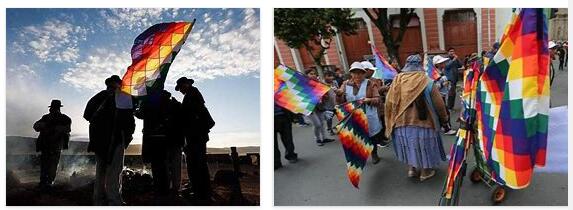Life in the highlands
Many Indians live in the Andes highlands. They have partly retained their traditional way of life. They still prefer to wear their colorful clothes rather than t-shirts or suits. It is woven from the wool of alpacas or llamas. The clothes have geometric patterns. Sometimes they depict animals or figures. The President of Bolivia Evo Morales, an Aymara Indian, is known for wearing a chompa when he is invited to other heads of state. It’s a sweater with a pattern.
Awayos
The Awayos are also typical. These are rectangular fabrics with stripes and patterns. The stripes must represent a contrast in their colors and also alternate in their thickness. Only then is the fabric an Awayo! In the photo you can see that they come in all colors. They are mainly used as a sling for babies, but they are also used to transport other loads, such as firewood. Awayos can also be used as tablecloths.
The Andean Cross
A typical symbol that can be found in fabrics is the Andean cross. It is called Chakana by the Indians. It comes from the Inca and is a symbol of their empire. It can not only be found on fabrics, but also as jewelry or on walls and pots.
The poncho
Another typical piece of clothing is the already mentioned poncho. It’s a piece of fabric with a hole in the middle through which you stick your head. We now have ponchos too, so you may know him. In the case of the Indians, they are usually also very colorful and patterned.
Cholitas
Traditionally dressed women are called cholitas (pronounced: cholitas). You wear an overskirt with up to ten petticoats and a shawl. They also have a hat on, which to us looks like the British bowler hat.
How come You don’t really know. There are two explanations: British railway engineers brought the hat with them to Bolivia. Because their bowler was not good for sun protection, they gave it away and hey presto the bowler hat sat on the head of the Indian women!
Another version says that an Italian hat maker accidentally delivered the bowlers to Bolivia, but the men did not buy them there. That’s how they were sold to women… The tradition has been around for about 100 years. In Bolivia this hat is called Bombín.
Pachamama
The Quechua and Aymara Indians are almost all Catholic, but they still maintain old traditions in religion. So they worship the ancient Inca deities: the sun god Inti and the earth mother Pachamama. Pachamama sometimes merges with Mary, the Mother of God.
What would you be called if you were born in Bolivia?
In any case, you would have two surnames. As is usual in Spanish-speaking countries, a child is given the father’s and mother’s last name. There are typically Spanish surnames such as Flores or García, but also indigenous names such as Mamani, Quispe, Condori, Choque and Huanca.
Boys are often called Juan Carlos, Hugo, Antonio, Miguel or Pablo. Can you guess what these names would be called in German? You can find the solution at the bottom of this page! At the moment, girls are particularly often named Martha, Laura, Ana Patricia, Sonia, Lucía or Paula.
How do you greet each other in Bolivia?
Good friends hug in greeting in Bolivia. You shake hands with acquaintances, like with us. They say ” Buenos días “, that means hello, or simply ” Hola “, that means hello, but when they say “Olla”!
What do the children play in Bolivia?
An old game from Bolivia is La Palma. You need a stick and a ball. The stick is stuck into the ground. From there you walk 18 steps and draw a line on the floor after every three steps. If you hit the target with the ball from the 18-step line, you may advance one line. Whoever hits the target first from the first line wins.
What are zebras doing in La Paz?
Zebras live in Africa and not in South America! So what are zebras doing in La Paz? They help regulate road traffic! Of course, these are not real zebras, but people in zebra costumes. They stand at zebra crossings and help regulate traffic there.
The traffic in the city had increased so much in 2001 that chaos threatened. Many people didn’t even know the rules of road traffic, for example how to cross a zebra crossing. The zebras also go to schools, for example, and give traffic lessons there.
What is the Wiphala?
The Wiphala is a symbol or symbol of the indigenous people of the Andes, the indigenous population. It is often used as a flag. It is square and consists of 49 squares in seven colors. Their arrangement depends on which of four regions they represent. This can be seen in the color that runs through the middle.
If this is white, as in the photo, it is the region called Qullasuyu. The Aymara see this region as their place of origin. The wiphala became the symbol of the entire indigenous population of Bolivia. In Bolivia, the Wiphala has been allowed to be used as an additional flag alongside the official national flag since 2009.
Solution: The Spanish names Juan Carlos, Hugo, Antonio, Miguel and Pablo would be Hans Karl, Hugo, Anton, Michael and Paul in German.
